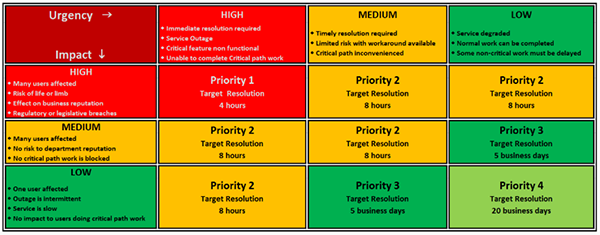Date Published December 6, 2018 - Last Updated February 13, 2019
HDI members are a group of community-minded problem solvers. They take their jobs of managing people, process, and technology quite seriously, but they also love to help each other excel in their careers. HDIConnect is a one-stop destination where HDI members gather for peer learning, collaboration, and knowledge sharing. Today, we’re sharing a recent discussion from Connect about managing the SLA clock.
Q: I'm curious about how other organizations apply the SLA within their ITSM tool.
We are a policing service that operates 24/7, but our service center function is only open 7:30 am to 5:30 pm Monday to Friday. As calls come into our service center, we prioritize the call based on urgency and impact and assign a priority of 1–4 (see table below). Because most of our client base works on rotating shifts, it's difficult to resolve their calls within the SLA timeframes because we cannot contact them or they cannot contact us during business hours. So, we have a status of “waiting for the customer” which will stop the SLA clock until the client gets back to us. We also have two other status options that will stop the SLA clock. Although, at the time, I agreed with the validity of stopping the SLA clock, I think they are being misused to avoid SLA breaches.

Does anyone else out there allow for a status that will stop the SLA clock? How do you manage this?—Anna B.
It's difficult to resolve their calls within the SLA timeframes.

A:
We, too, have a similar status, and our tickets automatically start the SLA clock once client responds. This is agreed between client and IT.
If your SLA is between your service center and client, then your SLA should only be active during your hours of operation. Typically, ticketing systems will allow for this so long as you define it.
Our SLAs also vary based on service catalog.—Xavier I.
A: Your SLA is setup perfectly and defined well. Xavier is correct, in the fact that your system should now determine the actual due date based on your hours of operation. Ours knows that we are only open 7:30–4:30 (excluding holidays and weekends), so hours are not calculated while we are closed.
If you truly are 24x7, however, your SLA is pretty much going to be exactly what you have defined, meaning every minute truly will count.—Josh S.
A: Thank you both for your response. Our SLA clock takes into consideration our hours of operation only (7:30 am –5:30 pm, Monday–Friday) and not the 24-hour clock.—Anna B.
A: So, there are two ways to look at this:
Measurement of customer experience: You could set up an SLA that runs 24/7 to show the actual experience of your customer from the time that they open an incident until the time that it's resolved.
Measurement of your performance: You could set up an SLA that runs only during the hours that your service desk is open to show what type of service you can provide with the constraints that you have.
Everything tells a story. If there is a business case for expanding your hours, having the first SLA in place will tell the story of how the customer experience could potentially be improved with expanded hours.
The second measurement is the one to use to evaluate your staff. You mentioned that people might be stopping the clock for reasons other than being closed. In my world, the only time I stop the clock is when sending a ticket to an external vendor to replace a piece of failed hardware. That's a pretty cut and dried scenario, no margin for abuse to try and avoid a breach.
Hope this helps.—Gil B.
A: Thanks Gil. I appreciate your insight, gives me pause for thought as to which agenda I would like to push.—Anna B.
Gil has a great point of view. (I would, however, rethink the “hardware out for repair” scenario; that figures into the customer experience as well, even though you have no—or very little—control over it. You could amend the SLA to reflect that services from third parties are treated differently.)
Remember that SLA stands for Service Level Agreement. What do your customers want? What are they focused on? What are you trying to measure? Is it simply a case of not being penalized for being in breach of SLA, or are you really trying to manage the relationship with your customer better? How you manage this will vary from organization to organization. There’s no “right way,” but watch out for ways to “game” the system by stopping the clock unnecessarily.
—Roy Atkinson, Senior Writer/Analyst, HDI
Join the conversation with your peers at HDIConnect.
HDI is the first professional association created for the service and support industry. Since its founding in 1989, HDI has remained the source for professional development by offering resources to promote organization-wide success through exceptional customer service. We do this by facilitating collaboration and networking, hosting acclaimed conferences and events, producing renowned publications and research, and certifying and training thousands of professionals each year. At 150,000 people strong, HDI is a community built by industry peers and leaders that gives its members the resources, knowledge, and drive to be great at what they do.